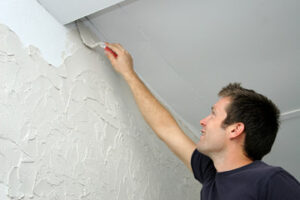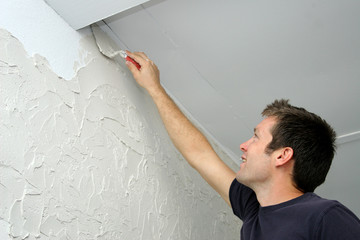Drywall is a great building material, but it is prone to damage. Fortunately, minor dents and scratches can often be repaired using joint compound (also known as drywall mud) and some sanding. Tiny holes from nails, screws, hooks, picture hangers, and wall anchors can be fixed by filling them with drywall mud or spackle and then lightly sanding the surface. This is a quick and easy repair that only takes minutes to complete. Read on Drywall Repair Las Vegas to learn more.
 Drywall repair can be a satisfying DIY project but requires the right tools. You’ll find drywall repair tools at home improvement stores, hardware shops and online. You may even have some already in your toolbox or kitchen drawer. Some are designed for large repairs, while others are ideal for smaller jobs.
Drywall repair can be a satisfying DIY project but requires the right tools. You’ll find drywall repair tools at home improvement stores, hardware shops and online. You may even have some already in your toolbox or kitchen drawer. Some are designed for large repairs, while others are ideal for smaller jobs.
One of the most useful drywall repair tools is a tape measure. It’s a great way to get accurate measurements without asking an assistant. It’s also handy for tracking how much mud you’re using, and it has a rigid design that prevents it from bending over time. Another important drywall repair tool is a drywall hammer. This type of hammer is specifically made for drywall and has a shaped head that minimizes damage to the wall when striking it.
A drywall saw is another important tool for cutting drywall and other materials like wood and metal. It’s a lot more precise than other saws and is often used to cut the edges of drywall after it’s installed. A drywall knife is another must-have tool for mixing and applying drywall compound. It’s also helpful for filling dents and repairing corners. Some drywall knives come with an attached plastic compound spreader, which saves you time by eliminating the need to apply another coat of mud over the knife.
For more extensive drywall repair, you should invest in a drywall router. This is a tool that can make light and heavy cuts in drywall. It also has a variety of bits that allow you to work with different materials and textures. A drywall router can be expensive, but it’s one of the most useful tools for any DIYer.
While no homeowner looks forward to repairing a hole in their drywall, the process is not difficult or expensive. With the right drywall repair tools and supplies, it can be done quickly and easily. Using the proper technique will give you a flawless result that’s almost invisible to anyone but you. However, if the damage is extensive or you’re not comfortable working with power tools, it’s best to hire a professional.
Drywall Repair Supplies
When repairing drywall holes, you will need more than just a few tools. Some holes require special materials to ensure a strong, high-quality repair. For example, a large hole may need an actual sheet of drywall or some sort of patch to reinforce the existing structure. For smaller holes, you can use spackle or joint compound along with a small putty knife and sanding block. When dealing with textured holes, you might also need a texture sprayer.
For a complete repair kit that has all the tools you need to do a professional job, look for one like the Stella Sealants Drywall Repair Kit Pro. This kit has everything you need to perform a quality DIY repair, including an actual sheet of drywall and wooden boards that will secure it, as well as drywall nails and a knife. This is a more thorough and ambitious kit than most, but it can be useful for anyone looking to do a high-quality repair independently.
Alternatively, you can find a more modestly priced kit with the basics. For example, the Homax Drywall Patch and Repair Kit contains everything you need to repair a small hole up to three inches wide. This kit features a spackling compound and self-adhesive patch that is easy to sand and paint once it sets. It’s a great option for beginners or anyone who doesn’t want to buy multiple specialized supplies.
Many repair kits come with a spackling knife or some other tool to help you get the job done. Some spackling knives are designed to be more durable than others and feature an ergonomic design that fits your hand better. This can make a big difference in how comfortable it is to hold and use.
Other drywall repair tools are more versatile and can be used for multiple purposes. For instance, some can also be used to scrape paint and putty from surfaces or to clean a surface before painting. Some can even be used to cut drywall, which is helpful when you need to shape the edges of a patch or other project.
Drywall Repair Techniques
Small dents, dings, and nail or screw holes in drywall can usually be patched with either spackle or joint compound. Use mesh tape in the corners of a patch and on both sides to strengthen the repair, reduce shifting, and prevent future holes. Apply a thin layer of joint compound over the damaged area, letting it dry between applications. Then use a putty knife to smooth the surface and feather the edges. This helps the drywall repair blend in with the surrounding wall. Choose self-primed spackle for small DIY jobs to save time and eliminate the need for a separate primer coat, which can cause the spot to look different than the rest of the wall.
Cracks in drywall are more difficult to fix than holes, but the method used depends on the severity of the crack. Hairline cracks are common around windows and doors, caused by the house settling and lumber shrinkage in the framing. These cracks can be filled with a flexible drywall compound that will move with the house and prevent them from reappearing.
Larger cracks or humps in drywall will require a larger patch and may need to be reinforced with metal strips if the crack extends across a door frame or into a ceiling. If the crack is isolated, use a putty knife to apply a thin layer of joint compound over it and press paper tape into place. Once dry, sand the crack to remove ridges and create a smooth surface for painting.
If the entire edge of a piece of drywall is damaged, it will likely need to be replaced. This is easier than it sounds, but it requires a bit more skill and practice. Start by putting down a thin bed of drywall joint compound and pressing the paper tape into place. Then, spread a second coat of compound over the tape to fill in the hole and smooth the surface. Use a wide putty knife to make sure that the compound extends evenly and don’t forget to sand and prime the repaired area.
Drywall Repair Tips
A small hole or crack in drywall can detract from the look of your home. But with the right tools and a little drywall repair know-how, you can fix the problem yourself.
When repairing small holes, start by identifying the source of the problem. A stud, a metal strip called corner bead or a nail pop are common causes of holes in drywall. You can identify a stud by using a level and drawing a vertical line along the surface of the wall to center the next horizontal line on a wall stud. Identifying the location of a stud is important because utilities, including electrical wiring and plumbing, run along drywall’s studs. Avoid cutting these wires or pipes by locating the stud locations before beginning any drywall repairs.
Unless the drywall is damaged beyond repair, fill in the hole with a thin layer of spackle or joint compound. Choose a product that dries quickly so you can complete the repair sooner. Apply the compound with a putty knife, smoothing it out as you go. After the first coat dries, apply a second coat and sand it smooth. When you’re done, sand the area again lightly with 100-grit sandpaper to smooth the repaired surface. Then, prime and paint the area.
Nail or screw pops are often caused by lumber shrinkage, a loose nail or screw, or a loose piece of drywall that hasn’t been fixed properly. Use a utility knife to cut away any protruding surface paper or gypsum. Then screw or nail in a new screw or a drywall nail that’s the same size as the old one. Apply a small amount of spackling compound over the nail or screw, smoothing it out with a putty knife as you work. Allow the compound to dry, sand it again with 100-grit sandpaper, and then prime and paint.
Hairline drywall cracks aren’t as dangerous as they sound. They’re caused by settling in your home, and are usually limited to one or two inches in length. Instead of repairing these hairline cracks, which may require more expensive materials, simply spray them with an elastic crack cover-up such as Good-Bye Cracks. Follow the application directions on the label, and let the spray dry.
